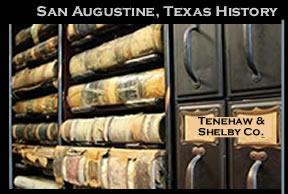 May 30, 2016 - The present (and next) issue of “We the People of Shelby County” (www.shelbycountytx.com) features many of our rural communities. In addition, that next issue will contribute to the celebration of Center’s 150th anniversary of its founding and also to the knowledge of Shelby (Tenehaw) County’s origins, now approaching 200 years ago.
May 30, 2016 - The present (and next) issue of “We the People of Shelby County” (www.shelbycountytx.com) features many of our rural communities. In addition, that next issue will contribute to the celebration of Center’s 150th anniversary of its founding and also to the knowledge of Shelby (Tenehaw) County’s origins, now approaching 200 years ago.
One such examination will be of character certificates, taken from local land office records after Texas gained its independence from Mexico. They provided identities for early immigrants to Texas, fixed their date and place of settlement, and shed light on their origins and their families. Genealogical researchers, then, have access through these documents to information about 5,000 early Texas settlers. The majority of those relative to Shelby County, however, were from the Municipality of San Augustine, established by Mexican law in 1834 and including a good portion of what is now southern Shelby County. So, early land grants and their related character certificates, including those classified and cataloged as "San Augustine," need serious consideration by Shelby County genealogists and historians.
To add more clarity to this relationship, the District of Tenehaw of the Municipality of San Augustine was made a separate municipality in 1835, of which the principal town was the Spanish village of Tenehaw (known as Nashville for a few years as it became anglicized, but now the town of Shelbyville). A year later, our local area's name was changed from the District of Tenehaw to Shelby County. Shelby County, which would then became one of the original counties of The Republic of Texas (originally including what is now Panola and Harrison Counties), comprised all of San Augustine north to the northern line of the municipality of Sabine, created in 1835, and north of the San Augustine/Shelby line as defined in 1837. ("The State-wide Records Indexing and Inventory Program," (April 1942) and George Crocket’s “Two Centuries in East Texas” (1932)
Since San Augustine is known as the first Anglo settlement in Texas (while Nacogdoches was an even earlier but primarily Spanish settlement), it gained historic attention that, in some cases, might otherwise have been given to Shelby County (especially Shelbyville). Many Americans seeking Texas land grants turned northwest after crossing Gaine's Ferry (the “Gateway to Texas”) and settled on Patroon Creek; others oriented themselves to the new frontier for a year or so in San Augustine and then moved into the fertile lands of southern Shelby County; and still others continued down El Camino Real into the interior of Texas.
In summary, then, our county's 19th century history should reflect that Shelby County was a part of the official Municipality of San Augustine (especially along Patroon Creek) as well as of the Nacogdoches District (generally, all of East Texas, but that is another story). Our traditional local history should also recognize that Shelbyville evolved from the Spanish village of Tenehaw and after that, only known briefly as Nashville. These were the times of Spanish and Mexican rule—before 1836 and at the beginnings of Anglo settlement and the emerging birth of the Texas Republic.









